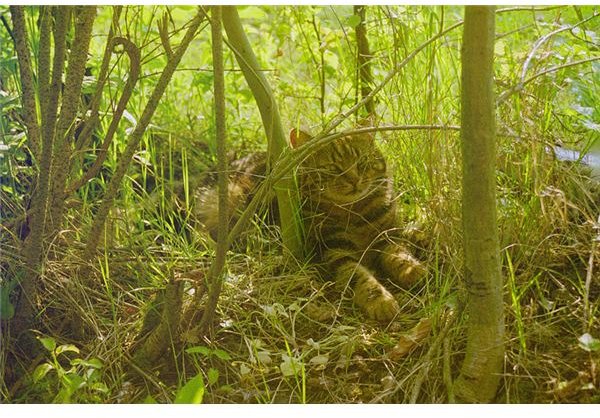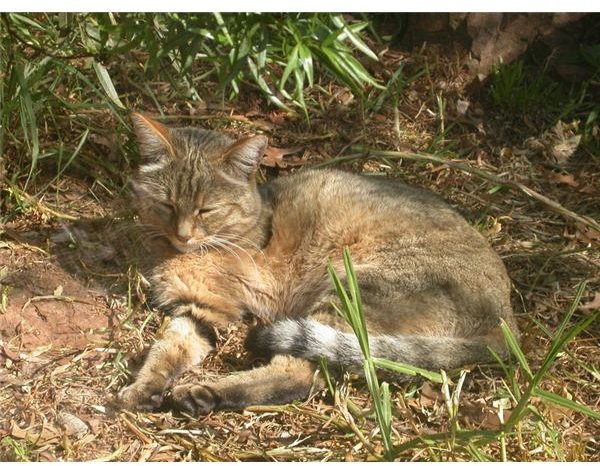History of the Cat: Genetic Evolution of Cats
The Domestic Cat
Unlike many other domesticated animals, such as dogs, house cats (Felis catus) have changed relatively little in appearance since they began living with humans. In size and morphology, they remain almost identical to their wild ancestor, the African Wildcat or Kaffir Cat (Felis silvestris lybica).
Genetic analysis has shown that domestic cats do not normally breed with their close relatives, the wildcats, even where populations overlap (Randi et al. 2001). They may therefore be considered a separate species. Even so, unofficial scientific names for the cat include F. silvestris catus and F. silvestris domesticus, in addition to F. domesticus.
Guess the Wildcat!


Two of these cats are ordinary house cats. One is actually an African Wildcat (Felis silvestris lybica) in a zoo. Can you guess which one? Leave a comment with your answer! Click on images to enlarge.
When and Where Cats Evolved
In the past, archaeological evidence has led experts to believe that the cat was first domesticated in Egypt only about 2000 years ago. (For example, see “The Cat Through Evolution” from Provet Healthcare Information.) This is astonishingly recent compared to other domesticated species. Analysis of feline DNA has led to serious reconsideration of both the time and place of cat domestication.
The wildcat, F. silvestris, consists of five subspecies, corresponding to five worldwide populations, which are reproductively isolated from one another by geography. In 2007, a group of researchers published a genetic study of all five populations along with domesticated cats, totalling 979 individual animals.
This genetic analysis showed that all domestic cats descended only from F. silvestris lybica, not the European Wildcat (F. silvestris silvestris) or any of the other subspecies. Mitochondrial DNA evidence shows at least five founders—ancestral individuals whose DNA is present in modern populations. Domestication was shown to have taken place not in Egypt, but in the Near East, most likely in the Fertile Crescent at the same time as the development of agriculture.
The analysis could not show exactly when cats began living with humans; it was only able to place a date very approximately at about 10,000 years ago, in line with most other domesticated animals. This result is consistent with archaeological evidence from Cyprus showing a close association between cats and humans from at least 9500 years ago.
How Cats Evolved
The characteristics of the cat—a relatively asocial nature, territoriality, a requirement for a meat-based diet, and a lack of usefulness to humans—suggest that domestication was the cats’ idea. Researchers into cat evolution speculate that it began when African Wildcats (which, despite their name, were present in the Near East) began to live near human settlements. Their motivation was the abundance of rodents that were taking advantage of grain stores, a result of the new technology of agriculture.
As anyone familiar with cats can tell you, the scenario of humans somehow forcing cats to perform this service is unlikely—cats likely began this behavior on their own. Another probable attractor was garbage from human settlements.
For these populations, there would have been strong selection pressure for tolerance of humans (tameness) and sociability, since many cats inhabited single areas. Humans, already appreciative of the rodent control, probably found cats attractive as well. They have round heads and large eyes, which humans are hard-wired to find “cute” (an adaptation to promote bonding between adults and babies). Cats evolved further from selection pressure to relate directly to humans.
Cats are therefore unique in that, unlike all other animals domesticated in antiquity, the primary reason people formed relationships with them was companionship.
Reference and Image Credits
- Driscoll et al. “The Near Eastern Origin of Cat Domestication.” Science 27 July 2007; 317(3837):519-23.
- Driscoll et al. “The Taming of the Cat.” Scientific American, June 2009.
- “The Cat Through Evolution.” Provet Healthcare Information.
- Ettore Randi et al. “Genetic Identification of Wild and Domestic Cats (Felis silvestris) and Their Hybrids Using Bayesian Clustering Methods.” Molecular Biology and Evolution 18:1679-1693 (2001)
Images:
- Left image by “Sonelle.” (CC) Some rights reserved (Creative Commons by-sa 3.0)
- Center image by Eigene Aufnahme (public domain), from Wikimedia Commons.
- Right image by “Clavecin” (public domain), from Wikimedia Commons.
